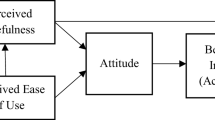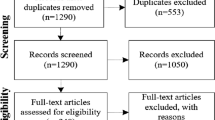Abstract
The substantial involvement of Adaptive User Interfaces (AUI) in providing adaptive and accessible interactive systems has created the need to establish a multimodal framework based on scalable adaptation rules. This paper presents an Adaptive User Interface to Accessibility Context (AUIAC) framework that provides a generic adaptation approach according to the model-driven engineering. It is based on a sequential and layered transformation from platform independent model (PIM) to platform specific model (PSM). It supports different reifications and transitions using adaptive transformation rules specified for each disability and modality. We illustrate the application of some rules on a sample user interface for the case of blind people. Then, we present some usability evaluation results from an empirical study.














Similar content being viewed by others
Data Availability
The datasets used during the current study are available from the corresponding author on reasonable request.
References
Abascal J, Aizpurua A, Cearreta I, Gamecho B, Garay N, Miñón R (2011) A modular approach to user interface adaptation for people with disabilities in ubiquitous environments. In: Internal technical report No. EHU-KAT-IK-01-11
Abrahão S, Insfran E, Sluÿters A, Vanderdonckt J (2021) Model-based intelligent user interface adaptation: challenges and future directions. Softw Syst Model 20(5):1335–1349
Akiki PA, Bandara AK, Yu Y (2016) Engineering adaptive model-driven user interfaces. IEEE Trans Softw Eng 42 (12):1118–1147. https://doi.org/10.1109/TSE.2016.2553035
Bendaly Hlaoui Y, Zouhaier L, Ben Ayed L (2018) Model driven approach for adapting user interfaces to the context of accessibility: case of visually impaired users. J Multimodal User Interfaces
Burzagli L, Emiliani PL, Antona M et al (2021) Intelligent environments for all: a path towards technology-enhanced human well-being. Universal Access Information Society
EcoreTools (2017) Graphical Modeling for Ecore. http://www.eclipse.org/ecoretools/. Accessed Jun 2021
Engel C, Müller EF, Weber G (2019) SVGPLott: an accessible tool to generate highly adaptable, accessible audio-tactile charts for and from blind and visually impaired people. In: Proceedings of the 12th ACM international conference on pervasive technologies related to assistive environments. ACM, pp 186–195
Firmenich S, Garrido A, Paternò F, Rossi G (2019) User interface adaptation for accessibility. In: Yesilada Y, Harper S (eds) Web accessibility. Human–computer interaction series. Springer, London
Gajos Z, Weld DS, Wobbrock JO (2010) Automatically generating personalized user interfaces with Supple. Artif Intell 174:910–950
Gonçalves TG, Oliveira KM, Kolski C (2018) Identifying HCI approaches to support CMMI-DEV for interactive system development. Comput Stan Interfaces 58:53–86
Henry SH (2010) Web content accessibility guidelines (WCAG) 2.0. https://www.w3.org/WAI/GL/WCAG20/. Accessed 2017
IBM (2019) SPSS software, Ibm.com. https://www.ibm.com/analytics/spss-statistics-software. Accessed 24 Feb 2020
ISO (1998) Ergonomics Requirements for office work with visual display terminals (VDTs)-Part 11: Guidance on Usability
ISO (2008) I S O 9241-171, Ergonomics Of human-system interaction Part 171: Guidance on software accessibility
ISO (2017) ISO/IEC DIS 40500 Information technology, W3C Web Content Accessibility Guidelines (WCAG) 2.0 (TC/SC: JTC 1)
Khan A, Khusro S (2019) Blind-friendly user interfaces a pilot study on improving the accessibility of touchscreen interfaces. Multimed Tools Appl 78:17495–17519
Kosmas P, Galanakis G, Constantinou V, Drossis G, Christofi M, Klironomos I, Zaphiris P, Antona M, Stephanidis C (2020) Enhancing accessibility in cultural heritage environments: considerations for social computing. Univ Access Inf Soc 19:471–482
Lewis JR, Sauro J (2009) The factor structure of the system usability scale. In: Human centered design. Volume 5619 of the series Lecture Notes in Computer Science, Springer, pp 94–103
Mitrovic N, Bobed C, Mena E (2016) A review of user interface description languages for mobile applications. In: the Tenth international conference on mobile ubiquitous computing, systems, services and technologies UBICOMM
Muller PA, Fleurey F, Jezequel JM (2005) Weaving executability into object oriented meta-languages. Model Driven Engineering Languages and Systems, pp 264–278
OMG (2001) Model Driven Architecture (MDA) document number ormsc/2001-07-01
Oliveira RF, da Mota Moura AM, Leite JCSP (2018) Reengineering for accessibility: a strategy based on software awareness. In: Proceedings of the 17th Brazilian symposium on software quality. pp 180–189
Paterno F, Santoro C, Spano LD (2011) A design space for user interface composition Model-Driven development of advanced user interfaces
Peissner M, Janssen D, Sellner T (2012) MyUI Individualization Patterns for Accessible and Adaptive User Interfaces. In: The First International Conference on Smart Systems, Devices and Technologies, pp 25–30
Peissner M, Schuller A, Ziegler D, Knecht C, Zimmermann G (2014) Requirements for the successful market Adoption of Adaptive user Interfaces for Accessibility. In: International conference on universal access in human-computer interaction, Springer, pp 431–442
Responsive Design (2020) Responsive web design basics. https://web.dev/responsive-web-design-basics/. Accessed 01 Jun 2020
Sauro J (2011) MeasuringU: what is a good task-completion rate? Measuringu.com. https://measuringu.com/task-completion/ (accessed 2017)
Sauro J (2018) Interpreting single items from the SUS. Measuringu :11. https://measuringu.com/sus-items/
Scott MJ, Spyridonis F, Ghinea G (2015) Designing for designers: towards the development of accessible ICT products and services using the VERITAS Framework. Comput. Stand. Interfaces 42:113–124
Seffah A, Donyaee M, Kline RB, Padda HK (2006) Usability measurement and metrics: a consolidated model. Softw Qual J 14(2):159–178
Skillen KL, et al. (2014) Ontological user modelling and semantic rule-based reasoning for personalisation of help-on-demand services in pervasive environments. Future Gener Comput Syst 34:97–109
Souidi E, Zouhaier L, Hlaoui YB (2022) Iot for real-time accessibility ontology population to context-awareness adapt user interfaces. In: 2022 IEEE 46th annual computers, software, and applications conference (COMPSAC), pp 1462–1467, DOI https://doi.org/10.1109/COMPSAC54236.2022.00232
Stata Statistical software for data science. http://www.stata.com/. Accessed 01 Jun 2020
Stephanidis C, Paramythis A, Sfyrakis M, Stergiou A, Maou N, Leventis A, Paparoulis G, Karagiannidis C (1998) Adaptable and adaptive user interfaces for disabled users in the AVANTI project. Springer, Heidelberg, pp 153–166
Vanderheiden GC, Treviranus J, Ortega-Moral M, Peissner M, de Lera E (2004) Creating a global public inclusive infrastructure (GPII). Springer, Cham, pp 506–515
WHO International classification of functioning, disability and health (ICF). http://www.who.int. Accessed 01 Apr 2017
Zouhaier L, Bendaly Hlaoui Y, Ben Ayed L (2017) Users Interfaces Adaptation for Visually Impaired Users Based on Meta-model Transformation. In: IEEE 41st annual computer software and applications conference
Zouhaier L, Hlaoui Y, Ayed L (2021) A Reinforcement Learning Based Approach of Context-driven Adaptive User Interfaces. In: 2021 IEEE 45th Annual Computers, Software, and Applications Conference (COMPSAC), Madrid, Spain, pp 1463–1468. https://doi.org/10.1109/COMPSAC51774.2021.00217
Zouhaier L, Hlaoui Y, Ben Ayed L (2017) Methodology for the development of accessible user interfaces based on Meta-Model transformations bendaly the case of blind users. In: CISIM 2017, LNCS 10244, pp 73–84
Author information
Authors and Affiliations
Corresponding author
Ethics declarations
Conflict of Interests
On behalf of all authors, the corresponding author states that there is no conflict of interest.
Additional information
Publisher’s note
Springer Nature remains neutral with regard to jurisdictional claims in published maps and institutional affiliations.
Yousra BenDalyHlaoui and Leila Ben Ayed are contributed equally to this work.
Rights and permissions
Springer Nature or its licensor (e.g. a society or other partner) holds exclusive rights to this article under a publishing agreement with the author(s) or other rightsholder(s); author self-archiving of the accepted manuscript version of this article is solely governed by the terms of such publishing agreement and applicable law.
About this article
Cite this article
Zouhaier, L., BenDalyHlaoui, Y. & Ayed, L.B. Adaptive user interface based on accessibility context. Multimed Tools Appl 82, 35621–35650 (2023). https://doi.org/10.1007/s11042-023-14390-5
Received:
Revised:
Accepted:
Published:
Issue Date:
DOI: https://doi.org/10.1007/s11042-023-14390-5




